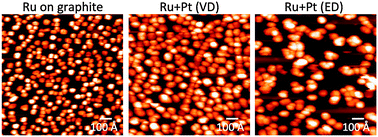Platinum–ruthenium bimetallic clusters on graphite: a comparison of vapor deposition and electroless deposition methods†
Abstract
Bimetallic Pt–Ru clusters have been grown on highly ordered pyrolytic graphite (HOPG) surfaces by vapor deposition and by electroless deposition. These studies help to bridge the material gap between well-characterized vapor deposited clusters and electrolessly deposited clusters, which are better suited for industrial catalyst preparation. In the vapor deposition experiments, bimetallic clusters were formed by the sequential deposition of Pt on Ru or Ru on Pt. Seed clusters of the first metal were grown on HOPG surfaces that were sputtered with Ar+ to introduce defects, which act as nucleation sites for Pt or Ru. On the unmodified HOPG surface, both Pt and Ru clusters preferentially nucleated at the step edges, whereas on the sputtered surface, clusters with relatively uniform sizes and spatial distributions were formed. Low energy ion scattering experiments showed that the surface compositions of the bimetallic clusters are Pt-rich, regardless of the order of deposition, indicating that the interdiffusion of metals within the clusters is facile at room temperature. Bimetallic clusters on sputtered HOPG were prepared by the electroless deposition of Pt on Ru seed clusters from a Pt+2 solution using dimethylamine borane as the reducing agent at pH 11 and 40 °C. After exposure to the electroless deposition bath, Pt was selectively deposited on Ru, as demonstrated by the detection of Pt on the surface by XPS, and the increase in the average cluster height without an increase in the number of clusters, indicating that Pt atoms are incorporated into the Ru seed clusters. Electroless deposition of Ru on Pt seed clusters was also achieved, but it should be noted that this deposition method is extremely sensitive to the presence of other metal ions in solution that have a higher reduction potential than the metal ion targeted for deposition.

- This article is part of the themed collection: Recent advances in the chemical physics of nanoalloys

 Please wait while we load your content...
Please wait while we load your content...